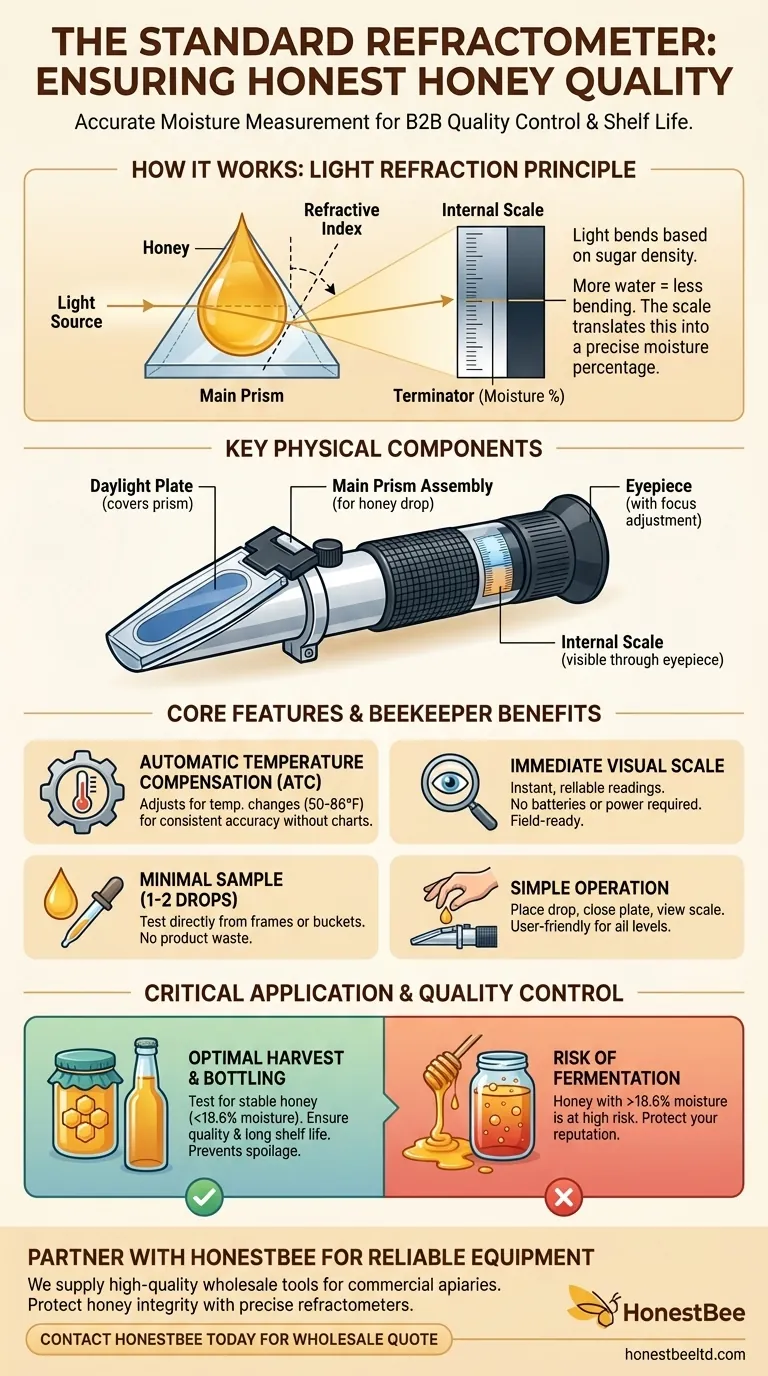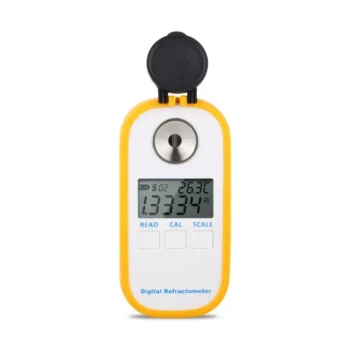At its core, the standard honey refractometer is a simple, analog tool designed for one purpose. It provides a quick and accurate measurement of the moisture content in honey by using just a single drop. Key features include a built-in visual scale calibrated specifically for honey, a simple eyepiece for reading, and a design that requires no batteries or external power.
A refractometer is not just a measurement device; it is a beekeeper's most reliable tool for quality control. It provides the critical data needed to decide when to harvest and to ensure the final product will not spoil or ferment, protecting both the honey's quality and the beekeeper's reputation.

How a Refractometer Translates a Drop of Honey into Data
To understand its features, you must first understand its function. The instrument works on the principle of light refraction.
The Principle of Light Refraction
When light passes from the air into a liquid like honey, it bends. The amount it bends is called the refractive index.
This index is directly and reliably correlated to the amount of dissolved solids—in this case, sugar—in the liquid. More water means less sugar density, which changes how the light bends. The refractometer's scale is calibrated to translate this change directly into a moisture percentage.
The Key Physical Components
A standard refractometer consists of a few simple parts working together:
- A daylight plate (or flap) covers the prism.
- A main prism assembly is where you place the drop of honey.
- An eyepiece with a focus adjustment allows you to get a sharp reading.
- An internal scale visible through the eyepiece shows the measurement.
The boundary between the light and dark areas on the scale, known as the "terminator," indicates the moisture percentage.
Core Features and Why They Matter for Beekeepers
Each feature of a standard honey refractometer is designed for practicality and accuracy in a beekeeping environment.
Immediate Visual Scale
The scale is viewed directly through the eyepiece and requires no batteries or digital processing. This makes the tool extremely reliable and ready for use anywhere, from the honey house to the apiary.
Minimal Sample Requirement
The need for only one or two drops of honey is a significant advantage. It allows you to test honey directly from a frame in the field or sample multiple buckets without wasting any product.
Simple Operation
The process is straightforward: place a drop on the prism, close the daylight plate, and look through the eyepiece. This user-friendly design makes it accessible to beekeepers of all experience levels.
Automatic Temperature Compensation (ATC)
Most modern standard refractometers include Automatic Temperature Compensation (ATC). Temperature affects the density of honey and can skew readings.
An ATC refractometer contains a small bimetallic strip that expands or contracts with temperature changes, automatically adjusting the scale for an accurate reading within a specific range (typically 50-86°F or 10-30°C). This is arguably the most critical feature for ensuring reliable results without needing correction charts.
Understanding the Trade-offs and Common Pitfalls
While highly effective, the standard refractometer requires proper handling to maintain its accuracy.
The Critical Role of Calibration
Your refractometer is only as accurate as its last calibration. It should be regularly checked using distilled water (which should read 0 on the Brix scale) or a specialized calibration liquid. A small screwdriver is used to adjust the scale back to the correct baseline if it has drifted.
Analog Simplicity vs. Digital Precision
The primary trade-off of an analog model is the potential for user error. Reading the precise point where the light and dark lines meet can be subjective. Digital refractometers eliminate this by providing a definitive numerical output, but at a higher cost and a reliance on batteries.
Cleaning and Maintenance
Any residue left on the prism from a previous reading will contaminate the next sample and lead to inaccurate results. The prism and daylight plate must be wiped clean with a soft, damp cloth and dried completely after every single use.
How to Apply This to Your Operation
Using a refractometer correctly moves you from guessing to knowing, empowering you to make critical management decisions.
- If your primary focus is harvesting at the perfect time: Use the refractometer to test uncapped honey in the hive. This helps you determine if the bees have sufficiently dehydrated it, preventing a premature harvest of "wet" honey.
- If your primary focus is honey quality and shelf life: Test every batch before bottling. Honey with moisture content above 18.6% is at high risk of fermentation, and a refractometer is the only way to guarantee it meets this critical standard.
- If your primary focus is consistency across batches: Regular testing allows you to blend different honey batches if necessary to achieve a consistent and stable final product.
Ultimately, a standard refractometer is an essential investment that empowers you to protect the quality and integrity of your honey.
Summary Table:
| Feature | Benefit for Beekeepers |
|---|---|
| Automatic Temperature Compensation (ATC) | Ensures accurate readings despite temperature changes. |
| Immediate Visual Scale | No batteries needed; provides instant, reliable results. |
| Minimal Sample (1-2 drops) | Test honey directly from frames or buckets without waste. |
| Simple Operation | User-friendly design accessible to beekeepers of all levels. |
Ensure the quality and shelf life of every batch of honey with reliable equipment from HONESTBEE.
We supply commercial apiaries and beekeeping equipment distributors with the high-quality, wholesale-focused tools they need to succeed. Protect your honey's integrity and your reputation with precise refractometers and other essential beekeeping supplies.
Contact HONESTBEE today to discuss your equipment needs and request a wholesale quote.
Visual Guide

Related Products
- Precision Honey Refractometer Instrument for Quality Assessment
- Digital Honey Refractometer for Precision Measurement of Optimal Honey Quality
- HONESTBEE 72 Frame Industrial Electric Honey Extractor for Beekeeping
- 6 Frame Manual Stainless Steel Honey Extractor Beekeeping Equipment
- 2 Frame Stainless Steel Manual Honey Spinner Extractor for Beekeeping
People Also Ask
- Why is a honey refractometer important for beekeepers? Ensure Quality and Prevent Fermentation
- Why is a honey refractometer essential for honey harvesting? Protect Your Harvest from Spoilage
- How does a honey refractometer work? Ensure Honey Quality & Harvest Readiness
- What are the benefits of using a Pocket Digital Honey Refractometer? Achieve Precision & Speed in Honey Quality Control
- What is a honey refractometer and what is its purpose? Ensure Honey Quality and Prevent Spoilage



















